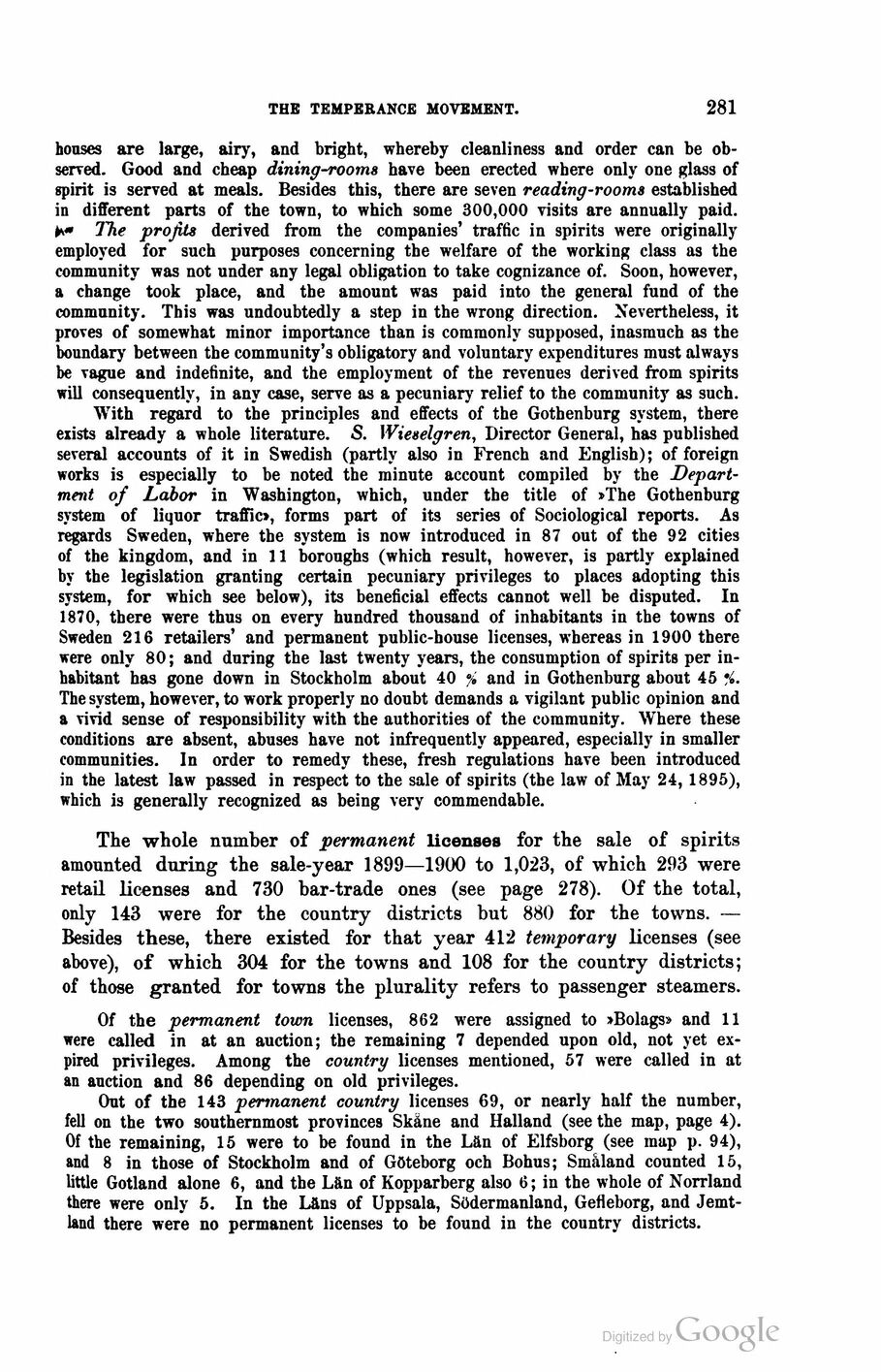
Full resolution (JPEG) - On this page / på denna sida - First part - III. Constitution and Administration - 5. Social Movements - The Temperance Movement, by K. Blomquist, Prison Gov., Kristianstad, and G. H. von Koch, Editor, Stockholm

<< prev. page << föreg. sida << >> nästa sida >> next page >>
Below is the raw OCR text
from the above scanned image.
Do you see an error? Proofread the page now!
Här nedan syns maskintolkade texten från faksimilbilden ovan.
Ser du något fel? Korrekturläs sidan nu!
This page has never been proofread. / Denna sida har aldrig korrekturlästs.
THE TEMPERANCE MOVEMENT.
281
houses are large, airy, and bright, whereby cleanliness and order can be
observed. Good and cheap dining-rooms have been erected where only one glass of
spirit is served at meals. Besides this, there are seven reading-rooms established
in different parts of the town, to which some 300,000 visits are annually paid.
The profits derived from the companies’ traffic in spirits were originally
employed for such purposes concerning the welfare of the working class as the
community was not under any legal obligation to take cognizance of. Soon, however,
a change took place, and the amount was paid into the general fund of the
community. This was undoubtedly a step in the wrong direction. Nevertheless, it
proves of somewhat minor importance than is commonly supposed, inasmuch as the
boundary between the community’s obligatory and voluntary expenditures must always
be vague and indefinite, and the employment of the revenues derived from spirits
will consequently, in any case, serve as a pecuniary relief to the community as such.
With regard to the principles and effects of the Gothenburg system, there
exists already a whole literature. S. Wieselgren, Director General, has published
several accounts of it in Swedish (partly also in French and English); of foreign
works is especially to be noted the minute account compiled by the
Department of Labor in Washington, which, under the title of »The Gothenburg
system of liquor traffic», forms part of its series of Sociological reports. As
regards Sweden, where the system is now introduced in 87 out of the 92 cities
of the kingdom, and in 11 boroughs (which result, however, is partly explained
by the legislation granting certain pecuniary privileges to places adopting this
system, for which see below), its beneficial effects cannot well be disputed. In
1870, there were thus on every hundred thousand of inhabitants in the towns of
Sweden 216 retailers’ and permanent public-house licenses, whereas in 1900 there
were only 80; and during the last twenty years, the consumption of spirits per
inhabitant has gone down in Stockholm about 40 % and in Gothenburg about 45 %.
The system, however, to work properly no doubt demands a vigilant public opinion and
a vivid sense of responsibility with the authorities of the community. Where these
conditions are absent, abuses have not infrequently appeared, especially in smaller
communities. In order to remedy these, fresh regulations have been introduced
in the latest law passed in respect to the sale of spirits (the law of May 24,1895),
which is generally recognized as being very commendable.
The whole number of permanent licenses for the sale of spirits
amounted during the sale-year 1899—1900 to 1,023, of which 293 were
retail licenses and 730 bar-trade ones (see page 278). Of the total,
only 143 were for the country districts but 880 for the towns. —
Besides these, there existed for that year 412 temporary licenses (see
above), of which 304 for the towns and 108 for the country districts;
of those granted for towns the plurality refers to passenger steamers.
Of the permanent town licenses, 862 were assigned to »Bolags» and 11
were called in at an auction; the remaining 7 depended upon old, not yet
expired privileges. Among the country licenses mentioned, 57 were called in at
an auction and 86 depending on old privileges.
Out of the 143 permanent country licenses 69, or nearly half the number,
fell on the two southernmost provinces Skåne and Halland (see the map, page 4).
Of the remaining, 15 were to be found in the Län of Elfsborg (see map p. 94),
and 8 in those of Stockholm and of Göteborg och Bohus; Småland counted 15,
little Gotland alone 6, and the Län of Kopparberg also 6; in the whole of Norrland
there were only 5. In the Läns of Uppsala, Södermanland, Gefleborg, and
Jemtland there were no permanent licenses to be found in the country districts.
<< prev. page << föreg. sida << >> nästa sida >> next page >>